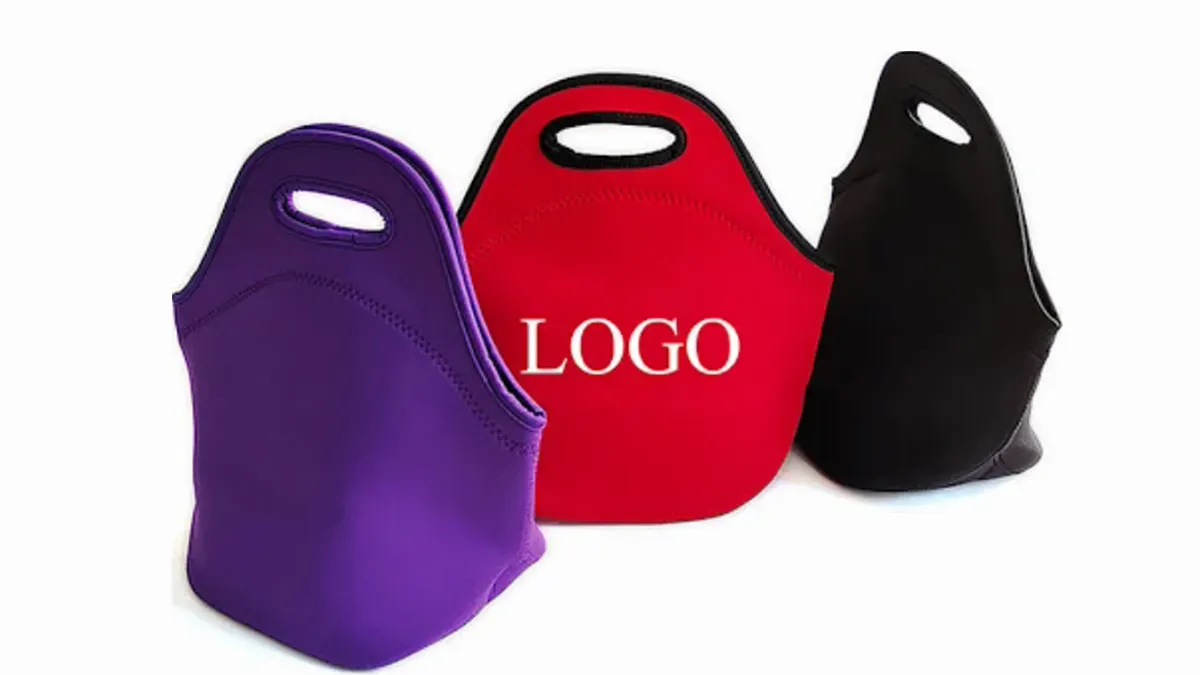If you have ever wondered are neoprene lunch bags safe, you are probably trying to figure out if they can hold your food without harmful chemicals. These bags are popular because they are soft, flexible, and keep meals at the right temperature. In this guide, we will dive into the materials, health considerations, and simple tips to use your bag safely every day.

What Is Neoprene?
Neoprene Material Overview
Neoprene is a type of synthetic rubber made from polychloroprene. You might recognize it from wetsuits, laptop sleeves, and yes, lunch bags. Its structure is flexible and water-resistant, which makes it perfect for keeping your food insulated.
Properties That Make It Popular for Lunch Bags
Neoprene is durable, lightweight, and soft, so it doesn’t crush your lunch. It also acts as an insulator, which means your food stays colder or warmer for longer periods. These qualities make it a go-to choice for many people looking for convenience and portability.
Health Safety Concerns of Neoprene Lunch Bags
While neoprene has many advantages, some people worry about its safety for food storage. Let’s break down the key concerns.
Chemicals in Neoprene
Neoprene contains polychloroprene and sometimes additives or residual solvents from manufacturing. Some bags may also include colorants or chemical finishes. This is why not all neoprene lunch bags are created equal.
Potential concerns include:
- BPA (bisphenol A)
- Phthalates
- Heavy metals in dyes or finishes
Choosing a high-quality, certified food-safe bag can minimize these risks.
Food Contact Safety
Food contact safety depends on whether the neoprene is FDA-approved or certified for food use. Some lower-cost bags may not meet these standards, which is a red flag.
Temperature is another factor. Neoprene can safely hold cold or room-temperature foods, but extremely hot meals can increase chemical migration if the bag is not certified food-safe.
Toxicity Risks
The big question: are neoprene lunch bags toxic? If the bag is high-quality and food-safe, the risk is minimal. Problems usually arise with cheaper, non-certified bags or if the bag is repeatedly exposed to high heat. Always check labeling for BPA-free, phthalate-free, and food-grade certifications.
BPA-Free and Non-Toxic Options
What to Look For in a Safe Neoprene Bag
A safe neoprene lunch bag should:
- Be BPA-free
- Be phthalate-free
- Have FDA-compliant labeling
These certifications indicate that the bag is designed to hold food without introducing harmful chemicals.
Alternatives for Sensitive Users
If you are still concerned, there are alternatives:
- Cotton or fabric bags lined with food-safe PEVA
- Silicone-based lunch bags that are flexible, reusable, and fully food-safe
These options are great for families with young children or anyone looking to minimize chemical exposure.
How to Use Neoprene Lunch Bags Safely
Storing Hot and Cold Foods
Neoprene is excellent for insulation, but there are limits:
- Cold foods: use ice packs to maintain freshness
- Hot foods: avoid storing piping hot meals for long periods; let food cool slightly before packing
- Separate compartments: use dividers or smaller containers for meat, vegetables, or snacks to prevent cross-contamination
Cleaning and Maintenance
Proper cleaning keeps your bag safe and odor-free:
- Hand wash with mild soap and warm water
- Avoid harsh detergents or bleach
- Rinse thoroughly and air dry completely
- Inspect for wear and tear regularly
If your bag has a removable liner, you can wash it separately, which extends the life of the bag.
Benefits of Neoprene Lunch Bags
Even with safety concerns, neoprene lunch bags have many advantages:
- Keep food insulated longer than standard fabric bags
- Flexible, lightweight, and easy to carry
- Durable and reusable
- Eco-friendly alternative to single-use plastic bags
These benefits make neoprene a practical choice for office workers, students, or anyone on the go.
Potential Drawbacks
Of course, there are a few downsides:
- Non-certified bags may have chemical residues
- Bags can trap odors if not cleaned properly
- Limited high-heat resistance—avoid putting boiling food inside
Understanding these limitations helps you make smarter choices and use your bag safely.
Tips for Choosing a Safe Neoprene Lunch Bag
Here are practical tips to pick the safest option:
- Check for certifications: FDA-compliant, BPA-free, and phthalate-free
- Consider the lining: some bags have extra PEVA liners for food safety
- Size and compartments: choose based on what you pack daily
- Ease of cleaning: removable liners or fully washable bags are best
- Eco-conscious options: reusable bags reduce waste compared to single-use alternatives
Frequently Asked Questions
Are neoprene lunch bags safe for kids?
Yes, if the bag is BPA-free and FDA-compliant. Always check labels before giving it to children.
Can you put hot food in a neoprene lunch bag?
You can, but avoid piping hot meals. Let food cool slightly to reduce chemical migration risk.
Do neoprene bags retain odors?
They can if not cleaned regularly. Hand wash and air dry after each use to prevent odors.
Can neoprene lunch bags go in the dishwasher?
Most bags are not dishwasher safe. Hand washing is recommended to maintain material integrity.
Are there eco-friendly neoprene alternatives?
Yes, consider silicone or PEVA-lined cotton bags for a fully eco-friendly solution.
Conclusion
Now you know are neoprene lunch bags safe—and the answer is yes, as long as you choose a high-quality, certified bag and follow proper usage and cleaning tips. Neoprene lunch bags are convenient, durable, and insulating, making them ideal for work, school, or travel.
We are a manufacturer offering premium neoprene lunch bags that are BPA-free, FDA-compliant, and customizable for your brand or bulk orders. Whether you want kids’ designs, adult styles, or insulated compartments, we can provide safe, high-quality options. Contact us today to request samples or get a quote for your next order.





